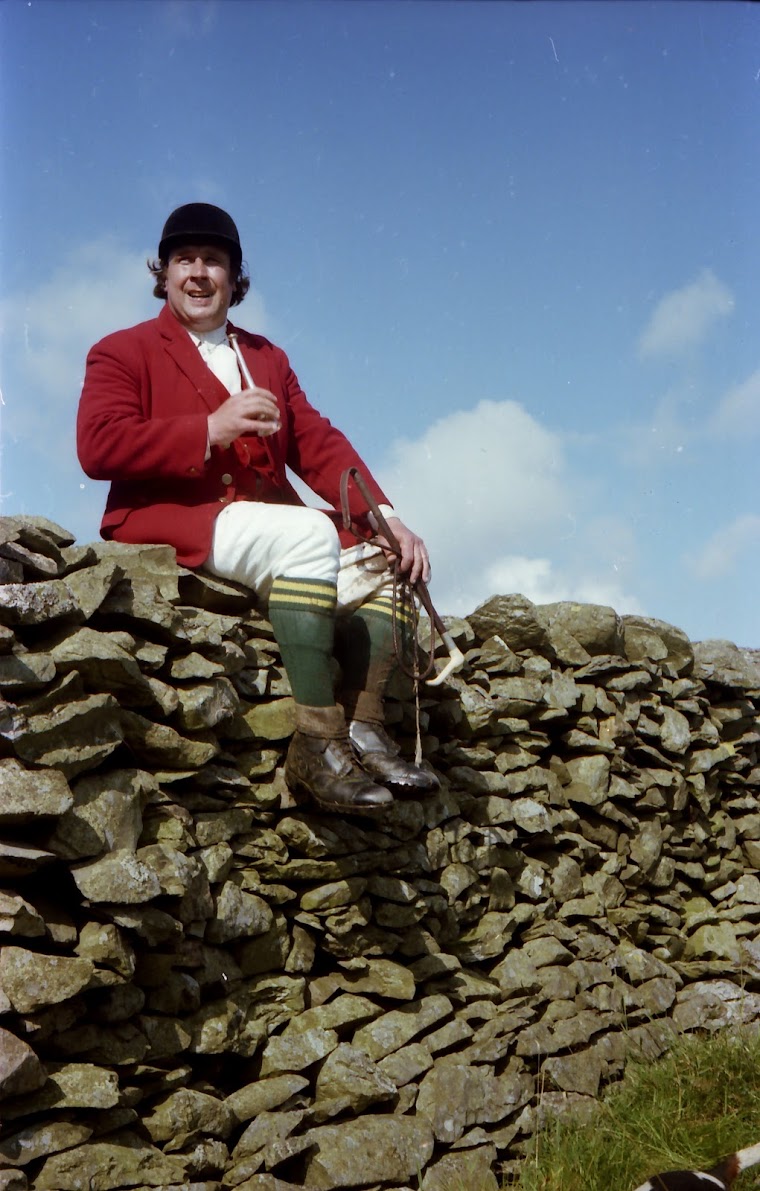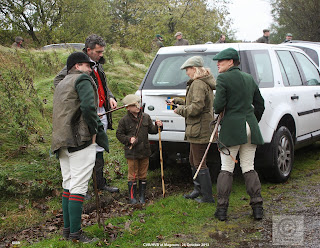As I am not beagling for a while and as the weather is indifferent I thought I would pick out and copy the rest of the possibly interesting images from the glass slides of my grandfather. In his day, he used to give local lantern shows with them. Years ago I sold his 'magic lantern' in a car boot sale. It was a big polished wood thing with a large brass lens holder. It wasn't entirely complete and I had hung onto it for years.
He worked at Normanton which had a big railway goods yard where I think he had some official capacity. I was under the impression he was like a station master. Working for the railway entitled him to free travel and he made full use of it. He also had a doctor friend with similar interests who had a car so they had trips together to follow their interest in old church architecture and other inanimate stuff so finding period images that relate today are few and far between.
Unfortunately I only have a collection of slides of around the year 1930 on the whole. As he had been doing it for many years a large weight of them must have been dumped at some point. Incidentally his father, Henry Lodge was a handloom fancy weaver and he and his wife Hannah lived in a small terraced house in Skelmanthorpe with the handloom. Skelmanthorpe, or Shat as it was called locally, was known for rug making in particular, and when I was young one could hear the odd handloom clacking away. There is a good little museum in a cottage with a handloom and kitted out in the fashion of a previous generation. Link here
Museum
The Huddersfield 'Tech' in its day was a center of excellence in textile technology. There was a room full of handlooms there used for design work. When it elevated to a University I understand they just scrapped all the handlooms.
My grandather must have had a photo of Skelmanthorpe in a frame that he photographed
Just enlarging the pic
A bit vague maybe but locals will recognise it. That is the main street in Skelmanthorpe and you can understand why houses needed boot scrapers illustrated in my blog about Skipton.
The only photo I could find of the goods yard at Normanton was of this unique railway engine passing through in 1930
LNER Locomotive No 1000
I found this explanation on the web -
The experimental Gresley W1 No. 10000 "Hush-Hush" was the only 4-6-4 tender locomotive to run in Britain*.
It included a number of experimental features including a marine type
water-tube boiler working at 450psi. Although this original design is
usually dismissed as a failure due to the revolutionary water-tube
boiler, No. 10000 did successfully work a number of high profile trains.
It never carried a name, although it was often referred to as the
"Hush-Hush" due to the initial secrecy of the project.
The locals will recognise this, the A6024 Holme Moss road below, where the Tour de France will toil its way over the hill. It is a road where they used to clear the snow as far as the TV station on the summit from this eastern side, but now I don't know if they even bother to do that. Roads over the Pennines seem to get 'Road Closed' signs put on them around here when it snows and they let nature take its course now the M62 exists. Today with a ride over Holme Moss on YouTube -
A6024
That was a
very slow ride if you watched it. In the old days a sheepdog used to
live in a kennel or barrel at the bottom of the hill to keep the sheep
from straying down the road. There were sheep in the video at the top
causing the bikes to slow. Now there are no sheep on these moors as
they are being rejuvenated quite successfully. They were much more
colourful this year.
Another that relates to it is this -
This is Bucker Brow at Settle.
The connection is the telegraph poles. One does not see telegraph poles like this nowadays with all those horizontals. It is interesting to Google these places -
Bucker Brow
It is good to see a real policeman.
When I was lad I had a pair of old roller skates stolen out of the wash house. The police caught the culprit. Another time a cherished rug was stolen from a washing line in the yard. The police caught the culprit. This time it was a wagon driver with no connection to us who took it and it was found in his living room. Nowadays one would not even consider reporting trivia like this knowing there is just no hope nor any real interest.
Newmiller Dam near Wakefield is a scenic spot. I suspect that is the doctor friend's car.
As for the rest, no particular order but sometimes alphabetically depending on how I titled them on my PC.
A closer look - yes I think it is the same car too.
Arrochar, Lock Long.
I think this paddle steamer is Lord of the Isles built in 1891. Unfortunately the landing staging obscures so much -
Lord of the Isles
The one below is the paddle steamer Jupiter on the Clyde in 1929 -
Jupiter
This is titled Bellanoch, Crinan Canal. I suppose these cottages have gone by now or got different roofing
Some nameless croft or blackhouse. Maybe it has been 'done-up' and is now some bijou holiday let.
Sticking to Scotland, this image below is entitled - Tolbooth, Edinburgh.
I got this info from the web - "The Tolbooth was built in 1591,
it was here that the tolls or public dues were collected.
It also served as the council house, courtroom and prison for the Canongate.
Although most of the prisoners were transferred to a newly built jail
on Calton Hill.
The
large clock face is dated 1820 and replaced an earlier clock from the
17th Century.
The
Latin inscription on the front of the building reads:
The place of the seal of the Burgh.
For one's country and one's successors, 1591."
Stirling Castle gateway
The Esplanade, Edinburgh - some things never change.
Poosie Nansies Inn
, Mauchline, Ayreshire Bit about it here - Poosie Nancy
Blythe village in Nottinghamshire. It looks like a car trip one as I think I can see it. Just beyond the cars is the Angel Inn - If you want to know more -
Blythe
Also Blythe
Boroughbridge, Yorkshire- St James's Square fountain. Looks like a coach driver in the white smack
Bramham, Yorkshire. I have just found the modern equivalent of this picture on here -
Bramham Village
Bridgewater, Somerset - Looking towards St Mary's Church
Dunster, Somerset, 1929
Old house, Dunster
East Quantoxhead, Somerset
East Quantoxhead, Somerset 1929
Porlock, Somerset 1929
Brixham, Devon 1931
Dartmouth, Devon Obviously a couple of training ships for the Royal Naval College but I can't find their identity
Oddicombe beach Devon
Plymouth Hoe, Devon 1932
River Dart, Totnes, Devon
Teigmouth Pier, Devon. It looks a bit different today. The little overhanging cabins have gone for a start.
Torquay
Weymouth, Dorset 1932
Broad Street, Ludlow. Shropshire. Never been, but looking at the web is seems a nice place.
Bridge Street, Chester - looks the same now but the people have moved on.
The Fauconberg Arms pub in Coxwold, North Yorkshire. All I know is that it dates back to the 17C
Bridlington Harbour
Scarborough, Yorks, Some nautical event. The lighthouse does not have a top on it here.
Lighthouse
High Street, Shrewsbury
The Original Cake Shop, Shrewsbury
Irelands Mansions, Shrewsbury -
Irelands Mansion was built between 1580 - 1590. It is a three storey
building with bays and gables projecting outwards which adds to the
buildings charm and piecemeal construction. It was constructed as a
speculative attempt to rent out each component part for shops on the
ground floor, offices above and accommodation in the garrets - a very
Dickensian affair!
By 1700 the building was known to locals as 'Ireland's Folly'.
Lincoln I wonder what the small cart is
'Pure Ices'
I don't know where this is
Notice the drinking fountain by the lamp post. Years ago, a friend had a heavy bronze bell shaped object on his mantlepiece and I discovered it was a cup from one of these and you can see it hanging down on the chain. It also reminds me there used to be drinking fountains around where one pushed a shiny brass knob and a low spring of water came up from a small nozzle set in a bowl so you could lean over and slurp it up. The last of the type in the picture that I saw was in Cawthorne near here, but that has probably gone for scrap by now.
St Botolph's Church, Thrumpington Street, Cambridge. Bit of history here -
St Botolph's
Something different - a man with a kestrel on his back.
Clapper bridge at Malham 1929. It look much the same there now -
Malham pics
Micklegate Bar, York. I wonder when the last policeman stood point duty and looked like this.
York
Hudderfield used to have a magnificent policeman who was well known, but whose name escapes me, who was frequently on point duty at the top of Kirkgate before traffic lights. Non of the limp wristed gesturing but fierce smart assertive semaphoring with efficient respected control of that junction in the centre of town. You will detect that nostalgia creeps in here and there on these posts!
I add the hyperlinks because I know there are as many visitors from abroad as from the UK, so they may enjoy something more current and informative to look up.
This is the entrance to Gough's cave in 1930 in the Cheddar Gorge of the Mendip Hills,, Somerset - Electrically illuminated!
Interesting attire -
Gough's Cave and
Wilkipedia
Blagrave's House Barnard Castle, Co Durham.
Blagraves House, now a restaurant, is the oldest house in the town. It takes its name from the
family who lived there in the 17th century and there is a crested
ceiling on the first floor with a panel dated
1672 and the initial WIB, No doubt in a much better state or repair now
While on the subject of eating -
Yorke Arms, Ramsgill in Nidderdale. North Yorks It looks the sort of place where you can enjoy an expensive Sunday lunch. Hasn't changed much as far as I can see from images on the web but doubtless costs more.
Settle market place in the Yorkshire Dales -
Settle
'Smeaton' it says on the slide which is in Yorkshire so this must be the River Went. Not sure which of the Smeatons this is as it depends on the side of the river it is located So it is either Kirk Smeaton or Little Smeaton
A closer look - bit like some of the buildings in the Colne Valley
Wheldrake is a village near York and that is its main street. Not really changed since 1929 -
Wheldrake - except for a lot more telegraph poles and wires and I daresay the finger post pointing to Elvington is long gone. Speaking of telephones, we didn't get one at home until around the 1950s as my father need one for work but everyone else seemed to be banned from it, I know I was. Never liked using the phone since.
Warmfield, near Wakefield, Yorkshire. Presume this old cottage has long gone
And finally -
Staithes, Yorkshire
That's it!
All are around 1930 unless otherwise stated but a year either side is neither here nor there.










































































 i
i




























